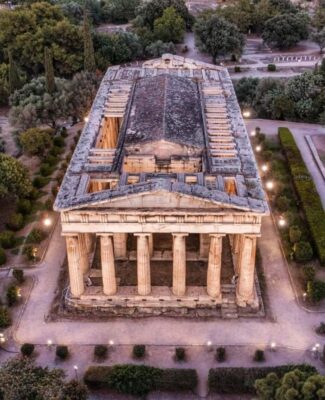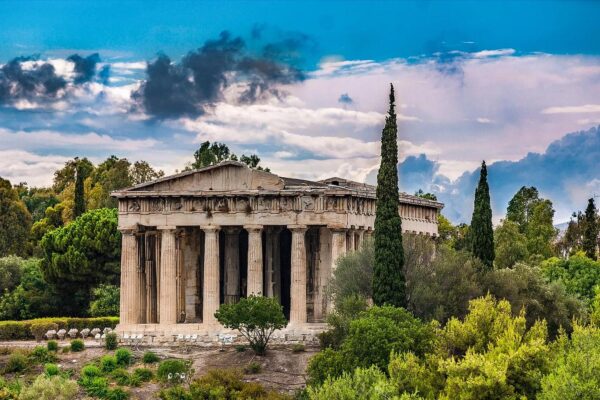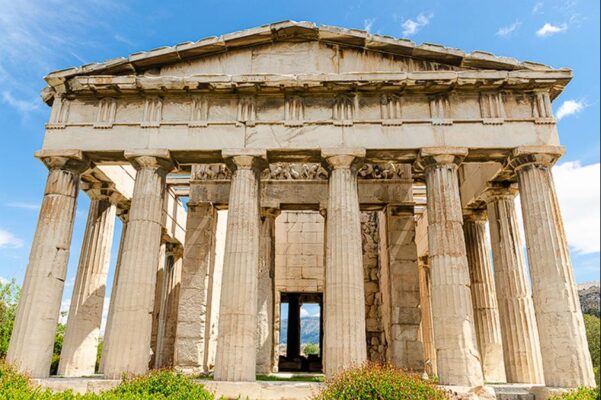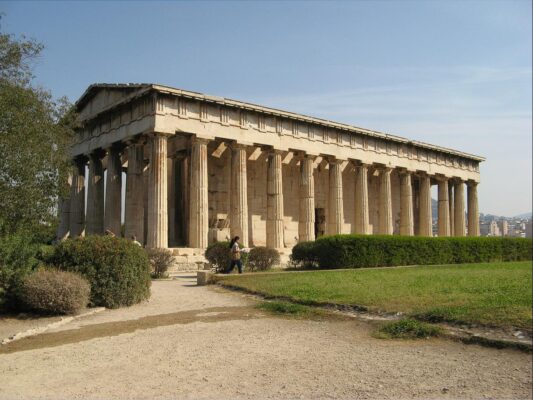The Temple of Hephaestus, or Hephaisteion, is a well-preserved Greek temple located on the Agoraios Kolonos hill in Athens. This Doric peripteral temple, dedicated to Hephaestus, the Greek god of fire and metalworking, stands as a testament to the architectural prowess and religious devotion of the ancient Greeks.
Architectural Grandeur and Historical Significance
The Temple of Hephaestus is renowned for its architectural integrity and historical significance, offering valuable insights into ancient Greek temple design and construction.
Doric Peripteral Design
The temple’s Doric peripteral design is a hallmark of classical Greek architecture, characterized by its symmetrical columns and harmonious proportions.

- Doric Order:
- The temple’s Doric order, with its simple and sturdy columns, reflects the austere beauty of classical Greek architecture.
- It is a prime example of Doric design.
- Peripteral Structure:
- The peripteral structure, featuring a single row of columns surrounding the temple’s central chamber, creates a visually stunning and balanced design.
- The design is very symmetrical.
- Architectural Harmony:
- The temple’s harmonious proportions and meticulous craftsmanship highlight the advanced architectural skills of the ancient Greeks.
- The temple is very well made.
Historical Context
The Temple of Hephaestus holds significant historical value, providing insights into the religious and cultural practices of ancient Athens.
- Dedicated to Hephaestus:
- The temple’s dedication to Hephaestus, the god of fire and metalworking, reflects the importance of these crafts in ancient Greek society.
- Hephaestus was an important god.
- Agora Location:
- Its location on the Agoraios Kolonos hill, overlooking the Agora of Athens, underscores its central role in the city’s civic and religious life.
- It was in a key location.
- Theseion Misnomer:
- The temple’s former misidentification as the Theseion highlights the historical complexities and evolving understanding of ancient sites.
- History can be confusing.
Preservation and Integrity
The Temple of Hephaestus is remarkably well-preserved, making it one of the best examples of ancient Greek temple architecture.

- Intact Structure:
- The temple’s largely intact structure allows visitors to experience the grandeur and beauty of ancient Greek architecture firsthand.
- It is very well preserved.
- Enduring Materials:
- The use of durable materials and meticulous construction techniques has contributed to the temple’s enduring preservation.
- The materials were very strong.
- Historical Significance:
- Its exceptional preservation enhances its historical significance, providing a valuable resource for studying ancient Greek architecture and culture.
- It is a valuable historical resource.
Cultural and Religious Significance
The Temple of Hephaestus served as a center of religious devotion and cultural expression in ancient Athens.
Religious Devotion
The temple’s dedication to Hephaestus reflects the ancient Greeks’ reverence for the gods and their importance in daily life.

- God of Fire and Metalworking:
- Hephaestus, the god of fire and metalworking, was revered for his craftsmanship and his role in providing essential tools and weapons.
- He was a skilled god.
- Temple Rituals:
- The temple likely served as a site for rituals and ceremonies honoring Hephaestus, reflecting the religious practices of the ancient Greeks.
- Rituals would have been performed there.
- Cultural Importance:
- The temple’s cultural importance extended beyond religious devotion, serving as a symbol of civic pride and artistic achievement.
- It was a symbol of the city.
Architectural Symbolism
The temple’s architectural design and decorative elements convey symbolic meanings, reflecting the values and beliefs of the ancient Greeks.
- Doric Symbolism:
- The Doric order, with its emphasis on strength and simplicity, symbolized the virtues of the ancient Greeks.
- The design had meaning.
- Sculptural Decoration:
- The temple’s sculptural decoration, including friezes and metopes, depicted mythological scenes and divine figures, reinforcing religious narratives.
- The decorations told stories.
- Sacred Space:
- The temple’s design created a sacred space, inviting worshippers to connect with the divine and seek the blessings of Hephaestus.
- It was a holy place.
Historical Legacy
The Temple of Hephaestus stands as a lasting legacy of ancient Greek civilization, inspiring awe and admiration from visitors around the world.

- Tourist Attraction:
- The temple’s historical significance and architectural beauty make it a popular tourist attraction, drawing visitors from around the world.
- Many people visit it.
- Educational Resource:
- It serves as an invaluable educational resource, providing insights into ancient Greek architecture, religion, and culture.
- It is a great place to learn.
- Cultural Icon:
- The Temple of Hephaestus remains a cultural icon, symbolizing the enduring legacy of ancient Greece and its contributions to Western civilization.
- It is a symbol of Greek culture.
The Temple of Hephaestus, with its Doric grandeur and historical significance, stands as a testament to the architectural and cultural achievements of ancient Greece. Its enduring presence on the Agoraios Kolonos hill in Athens continues to captivate and educate visitors, offering a glimpse into the rich heritage of a bygone era.

CÁC TIN KHÁC
Mary Walton: The Forgotten Inventor Who Helped Clean Up America’s Cities
Tomb of Queen Nefertari in the Valley of the Queens, Egypt
Discover the Hypostyle Hall of the Temple of Hathor at Dendera
Venus de Losange: Unveiling the Mystery of a 20,000-Year-Old Paleolithic Icon